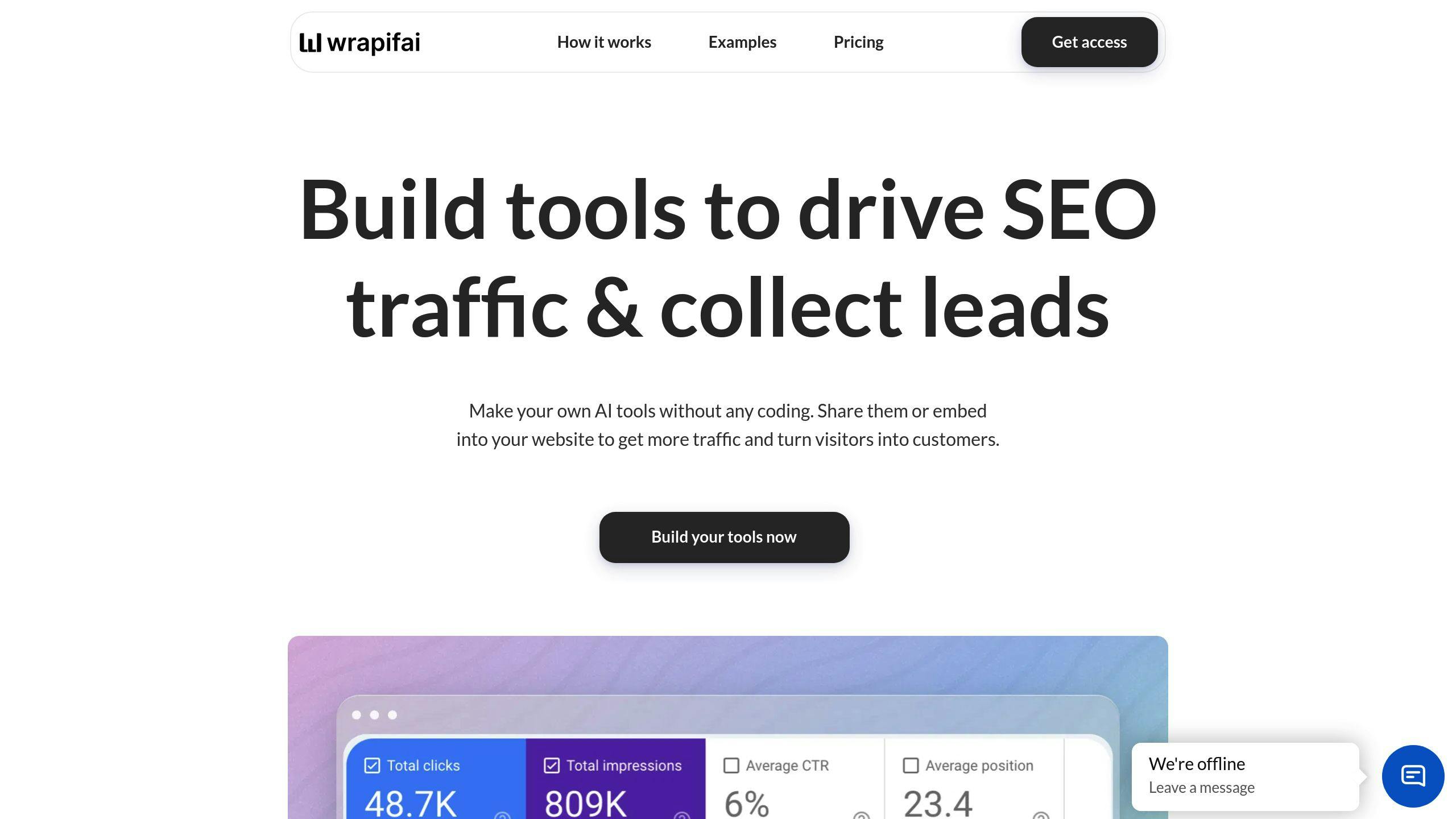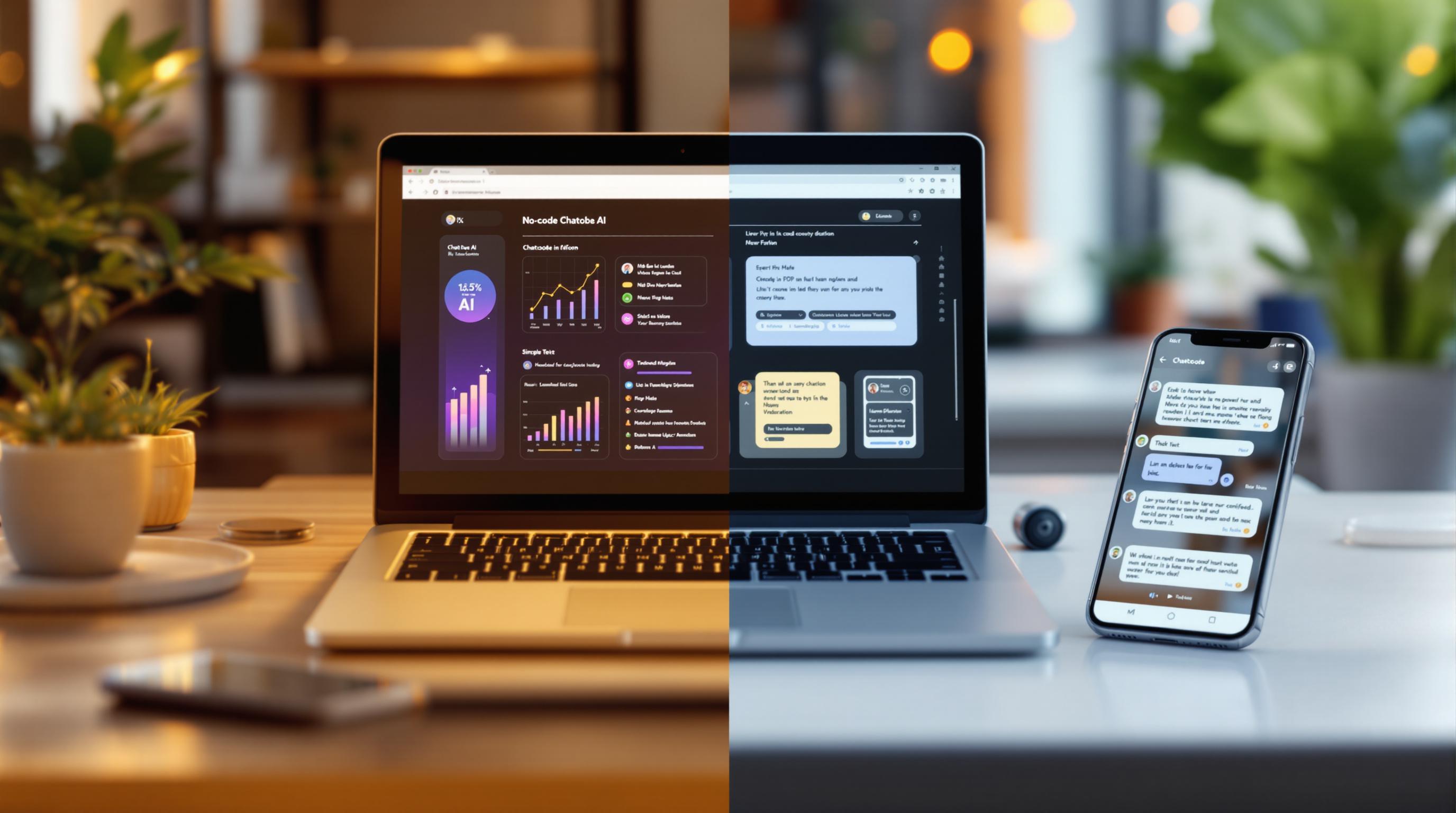No-code AI tools make it easy to add AI features to your website without writing code. They use drag-and-drop interfaces and templates, saving time and money. Here’s what you need to know:
Key Benefits:
- Better User Experience: Add chatbots or personalized recommendations.
- Cost-Effective: Affordable compared to traditional AI development.
- Quick Setup: Build tools in hours or days, not weeks.
How to Get Started:
- Define Your Goal: What problem will the AI tool solve? (e.g., boosting sales or automating support).
- Choose a Platform: Tools like Wrapifai, Bubble, or Zapier offer different features.
- Build the Tool: Use templates and customize them for your needs.
- Integrate It: Embed it into your website and test functionality.
- Track Performance: Monitor metrics like engagement and conversions to improve.
Popular Platforms:
- Wrapifai: Focused on website-specific AI tools.
- Zapier: Automates workflows and connects apps.
- Bubble: Builds interactive apps visually.
| Feature | Wrapifai | Zapier | Bubble |
|---|---|---|---|
| Use Case | Website AI Tools | Workflow Automation | Web App Building |
| Custom Branding | Yes | Limited | Yes |
| Scalability | High | Moderate | High |
No-code AI tools simplify advanced features, making them accessible for beginners. Start with free trials to explore what works best for you.
How To Build A $10,000 Website In 30 Minutes (AI + No Code)
How to Choose a No-Code AI Platform
Picking the right no-code AI platform can make a big difference in how quickly you can implement solutions and how easy they are to use. Here’s what to keep in mind when making your choice.
Key Features to Consider
When looking at no-code AI platforms, focus on these important features:
| Feature | Why It Matters |
|---|---|
| Integration Options | Makes it easier to connect with other tools and systems |
| Customization | Allows you to align the tool with your brand |
| Scalability | Ensures the platform grows with your business |
| User Interface | Simplifies setup and daily use |
| Support & Documentation | Offers resources to help you learn and troubleshoot |
Once you know what features are most important for your needs, compare platforms to see which one checks the most boxes.
Overview of Wrapifai

Wrapifai is a platform designed specifically for creating AI tools tailored to websites. Here’s what it brings to the table:
- Custom Branding: Easily integrate AI tools that match your website’s look and feel.
- Performance Tracking: Monitor how your tools are doing and make adjustments as needed.
- Flexible Pricing: Options for everything from small projects to enterprise-level needs.
While Wrapifai is great for website-specific AI tools, you might want to explore other platforms if your goals differ.
Other No-Code AI Platforms
Here are a few other platforms that excel in different areas:
Zapier
- Perfect for automating workflows and connecting apps.
- Works with over 3,000 apps and services.
Bubble
- Great for building complex, interactive web apps.
- Offers a highly visual development environment.
- Provides solutions that can scale as your needs grow.
- Integrates deeply with a variety of services [3].
When deciding, think about your budget, technical needs, and plans for future growth. Many platforms offer free trials, so take advantage of those to test features before committing [3].
Steps to Build Custom AI Tools
Step 1: Define the Purpose of Your AI Tool
Figure out your website's specific goals and the problem your AI tool will solve. For example, are you aiming to boost sales or reduce customer support demands?
| Goal | Example AI Tool | Expected Outcome |
|---|---|---|
| Increase Sales | Product Recommender | Tailored shopping suggestions based on user activity |
| Reduce Support Load | Customer Service Chatbot | Automated, around-the-clock answers to FAQs |
| Improve Engagement | Content Personalizer | Content that adjusts dynamically to user preferences |
Step 2: Choose and Set Up a No-Code Platform
Pick a no-code platform that aligns with your goals. For instance, Wrapifai (mentioned earlier) offers features like branding tools and performance tracking to simplify the process. Familiarize yourself with the platform’s interface and capabilities to get ready for the next steps.
Step 3: Design and Build the Tool
Choose a template that fits your needs, customize it to reflect your brand, and set up the AI settings for your specific use case. Test the tool in a controlled environment to ensure it works as intended.
Step 4: Add the Tool to Your Website
Generate the embed code provided by the platform, insert it into your website’s HTML, and decide where the tool will appear. Test the integration across different devices and browsers to confirm everything functions smoothly.
Step 5: Track and Improve the Tool
Monitor the tool’s performance using analytics. Pay attention to key metrics like engagement, conversion rates, and error rates to understand how well it’s working and where adjustments are needed.
| Metric | What to Monitor | Why It Matters |
|---|---|---|
| User Engagement | Time spent interacting | Indicates how effective the tool is |
| Conversion Rate | Actions completed | Shows the tool’s impact on business goals |
| Error Rate | Failed interactions | Highlights areas that need improvement |
Leverage the platform’s analytics to fine-tune the AI’s responses and performance. Once optimized, your AI tool is ready to deliver results. Next, let’s look at real-world examples of how these tools can elevate your website.
sbb-itb-c495ab1
Examples of Custom AI Tools for Websites
These examples highlight how no-code AI tools can help businesses create professional solutions without needing technical skills.
AI Chatbots for Customer Support
AI chatbots built with platforms like Octane AI or Landbot offer round-the-clock customer support. They manage tasks like answering FAQs, tracking orders, and processing simple transactions. This reduces the workload for support teams and boosts overall efficiency.
| Chatbot Feature | Business Impact |
|---|---|
| FAQ Automation | Cuts support tickets by 40-60% |
| Order Tracking | Lowers support calls by 25-35% |
| Basic Transactions | Covers 30-40% of routine purchases |
| Multi-language Support | Expands reach to global audiences |
Tools for Personalized Recommendations
Platforms such as Directual and Webflow enable businesses to offer personalized recommendations by analyzing user behavior, including browsing patterns and purchase history. These tools update suggestions in real-time, increasing both engagement and sales.
AI for Automated Data Analysis
No-code tools like Tableau and MonkeyLearn make data analysis straightforward, turning raw data into useful insights. Businesses can track metrics like traffic, conversions, and user behavior to refine strategies and improve customer experiences.
| Analysis Type | Key Metrics Tracked | Business Benefits |
|---|---|---|
| Traffic Analysis | User flow, bounce rates, peak times | Refines content strategies |
| Conversion Tracking | Funnel performance, drop-off points | Boosts conversion rates |
| User Behavior | Click trends, time on page, engagement | Enhances user experience |
These tools can also connect with platforms like WhatsApp, Facebook Messenger, and Slack, creating a seamless experience across multiple channels [4]. They show how no-code AI tools can make a big difference for businesses, offering practical solutions for managing websites effectively.
Conclusion and Next Steps
Summary of Key Points
No-code AI tools have changed the game in website development, making advanced features accessible even to beginners and small businesses. These platforms allow users to create custom AI solutions without needing programming skills. For example, Bubble is great for building web apps, while Zapier helps automate tasks through workflows. With tools like these, you can tackle challenges like customer support, personalization, and data analysis more effectively.
Success depends on picking the right platform and following a clear plan. Once you've chosen your platform, dive deeper with focused resources and hands-on practice to refine your skills.
Resources for Learning More
If you're ready to take the next step, there are plenty of resources to help you get started with no-code AI tools. Industry forums and educational content can provide extra guidance, while platforms like HubSpot and Levity AI frequently share updated guides and case studies that highlight practical uses [2].
To build your skills, try free trials of tools like ChatBot, join no-code development communities, and stay informed by following industry blogs. Start small by creating projects that address specific business challenges [5]. These steps will help you not only understand the tools but also apply them effectively to your website while keeping up with the latest trends.
FAQs
Let's dive into some common questions about no-code AI tools to help you get started.
Are there any AI no-code tools?
Yes, there are plenty of no-code AI tools available to improve your website's functionality. Popular platforms like Bubble and Zapier are well-known, but there are also specialized options like Akkio, which focuses on business intelligence, predictive modeling, and lead scoring - ideal for sales and marketing teams [1].
Other notable tools include Voiceflow, which is great for creating conversational AI and virtual assistants, and Appypie, known for simple website integrations. These platforms cater to a range of needs, from automating customer support to analyzing data [2].
When choosing the right no-code AI tool, keep these factors in mind:
- Integration: Make sure the tool works well with your current systems.
- Scalability: Pick a platform that can grow with your business.
- Data security: Ensure the tool meets compliance and security standards [2].


